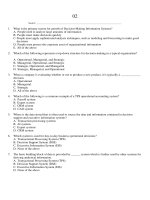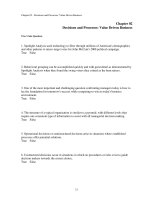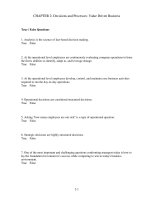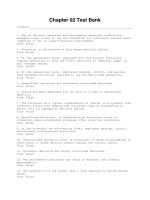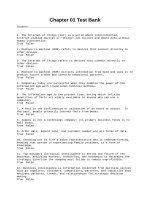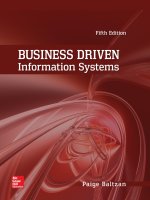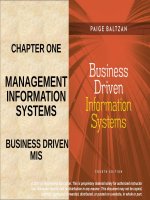Lecture Business driven information systems (4/e): Chapter 1 - Paige Baltzan
Bạn đang xem bản rút gọn của tài liệu. Xem và tải ngay bản đầy đủ của tài liệu tại đây (1.93 MB, 41 trang )
CHAPTER ONE
MANAGEMENT
INFORMATION
SYSTEMS
BUSINESS DRIVEN
MIS
© 2014 by McGraw-Hill Education. This is proprietary material solely for authorized instructor
use. Not authorized for sale or distribution in any manner. This document may not be copied,
scanned, duplicated, forwarded, distributed, or posted on a website, in whole or part.
2
CHAPTER ONE OVERVIEW
SECTION 1.1 – BUSINESS DRIVEN MIS
• Competing in the Information Age
• The Challenge: Departmental Companies
• The Solution: Management Information Systems
SECTION 1.2 – BUSINESS STRATEGY
• Identifying Competitive Advantages
• The Five Forces Model – Evaluating Industry
Attractiveness
• The Three Generic Strategies – Choosing a Business
Focus
• Value Chain Analysis – Executing Business Strategies
SECTION 1.1
BUSINESS
DRIVEN MIS
© 2014 by McGraw-Hill Education. This is proprietary material solely for authorized instructor
use. Not authorized for sale or distribution in any manner. This document may not be copied,
scanned, duplicated, forwarded, distributed, or posted on a website, in whole or part.
4
LEARNING OUTCOMES
1. Describe the information age and the
differences between data, information,
business intelligence, and knowledge
2. Identify the different departments in a
company and why they must work together to
achieve success
3. Explain systems thinking and how
management information systems enable
business communications
5
COMPETING IN THE
INFORMATION AGE
Did you know . . .
Avatar, the movie, took over 4 yrs
to make and cost $450 million
Lady Gaga’s real name is Joanne
Angelina Germanotta
It costs $2.6 million for a 30second advertising time slot
during the Super Bowl
6
COMPETING IN THE
INFORMATION AGE
act - The confirmation or validation of
an event or object
nformation age - The present time,
during which infinite quantities of facts
are widely available to anyone who
can use a computer
7
COMPETING IN THE
INFORMATION AGE
Examples of the power of business
and technology
• Amazon – Not a technology company;
primary business focus is selling books
• Netflix – Not a technology company;
primary business focus is renting videos
• Zappos – Not a technology company;
primary business focus is selling shoes
8
COMPETING IN THE
INFORMATION AGE
The core drivers of the information age
• Data
• Information
• Business intelligence
• Knowledge
9
Data
Data - Raw facts that describe the characteristics
of an event or object
10
Information
Information - Data converted into a meaningful
and useful context
11
Business Intelligence
Business intelligence Information collected from
multiple sources such as
suppliers, customers,
competitors, partners, and
industries that analyzes
patterns, trends, and
relationships for strategic
decision making
12
Knowledge
Knowledge - Skills, experience, and
expertise coupled with information and
intelligence that creates a person’s
intellectual resources
Knowledge worker – Individual
valued for their ability to interpret and
analyze information
13
THE CHALLENGE:
DEPARTMENTAL COMPANIES
Common Departments Working Independently
14
THE SOLUTION: MANAGEMENT
INFORMATION SYSTEMS
Common Departments Working Interdependently
15
THE SOLUTION: MANAGEMENT
INFORMATION SYSTEMS
16
THE SOLUTION: MANAGEMENT
INFORMATION SYSTEMS
17
THE SOLUTION: MANAGEMENT
INFORMATION SYSTEMS
Systems thinking – A way of monitoring the entire
system by viewing multiple inputs being processed
or transformed to produce outputs while
continuously gathering feedback on each part
18
THE SOLUTION: MANAGEMENT
INFORMATION SYSTEMS
Management Information Systems (MIS) –
A business function, like accounting and human
resources, which moves information about
people, products, and processes across the
company to facilitate decision-making and
problem-solving
19
MIS Department
Roles and Responsibilities
Chief information officer (CIO) – Oversees all
uses of IT and ensures the strategic alignment
of IT with business goals and objectives
Chief knowledge officer (CKO) - Responsible
for collecting, maintaining, and distributing the
organization’s knowledge
Chief privacy officer (CPO) – Responsible for
ensuring the ethical and legal use of
information
20
MIS Department
Roles and Responsibilities
Chief security officer (CSO) –
Responsible for ensuring the security of IT
systems
Chief technology officer (CTO) –
Responsible for ensuring the throughput,
speed, accuracy, availability, and
reliability of IT
SECTION 1.2
BUSINESS
STRATEGY
© 2014 by McGraw-Hill Education. This is proprietary material solely for authorized instructor
use. Not authorized for sale or distribution in any manner. This document may not be copied,
scanned, duplicated, forwarded, distributed, or posted on a website, in whole or part.
22
LEARNING OUTCOMES
4. Explain why competitive advantages are
temporary
5. Describe Porter’s Five Forces Model and
explain each of the five forces
6. Compare Porter’s three generic strategies
7. Demonstrate how a company can add value
by using Porter’s value chain analysis
23
IDENTIFYING COMPETITIVE
ADVANTAGES
Business strategy – A leadership plan that
achieves a specific set of goals or objectives
such as
Developing new products or services
Entering new markets
Increasing customer loyalty
Attracting new customers
Increasing sales
24
IDENTIFYING COMPETITIVE
ADVANTAGES
25
IDENTIFYING COMPETITIVE
ADVANTAGES
Competitive advantage – A product or service
that an organization’s customers place a greater
value on than similar offerings from a competitor
First-mover advantage – Occurs when an
organization can significantly impact its market
share by being first to market with a competitive
advantage
